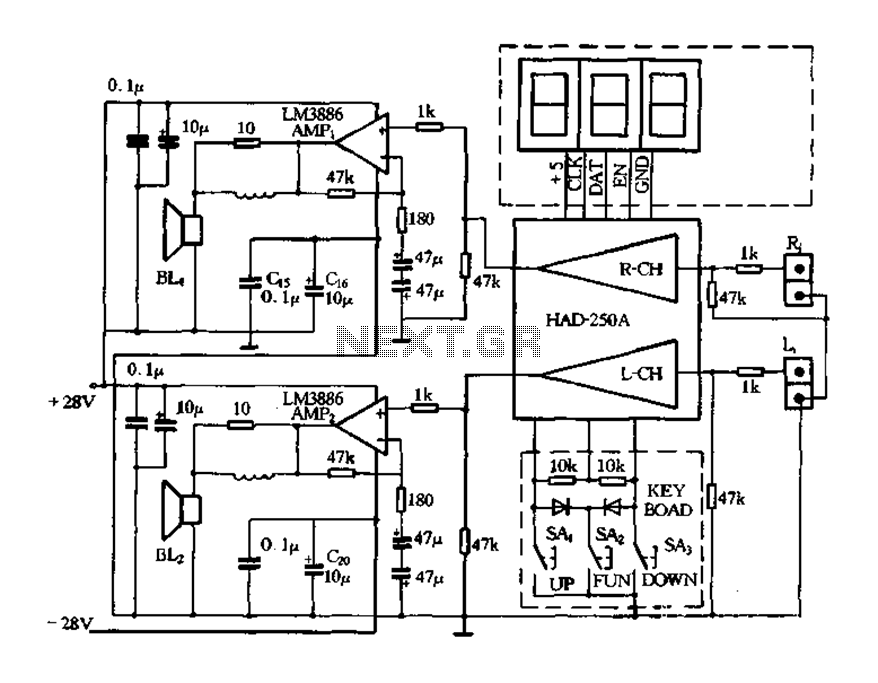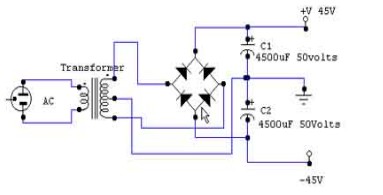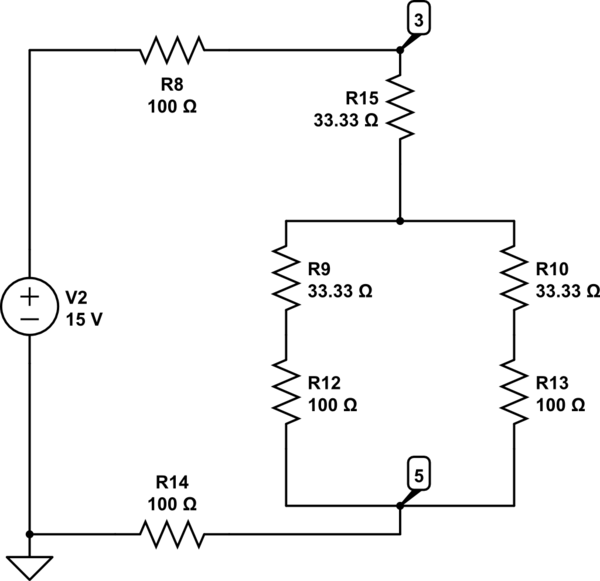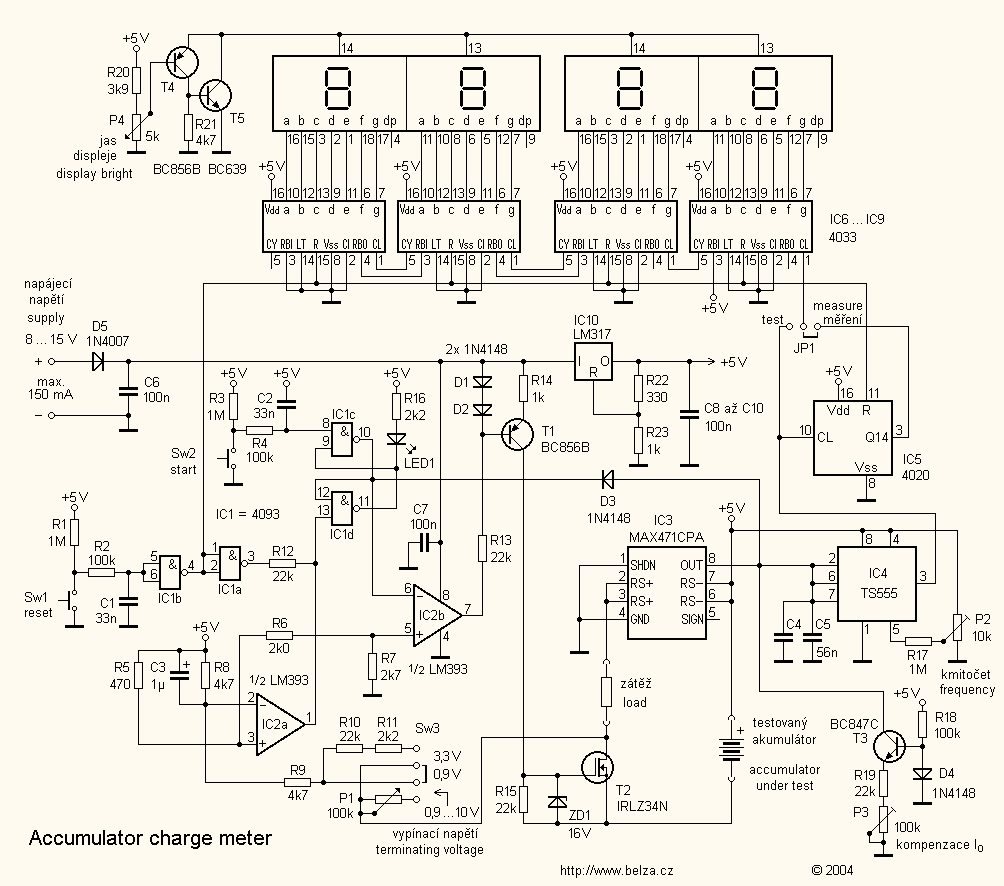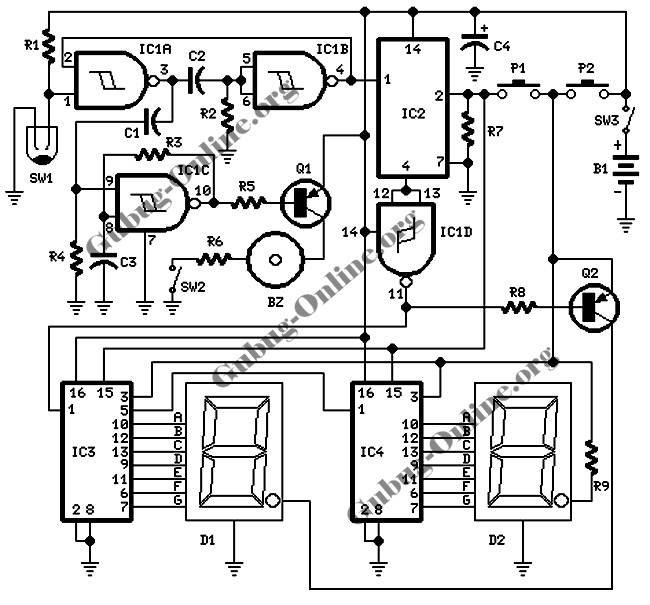
Adjustable Regulated Battery Charger circuit diagram
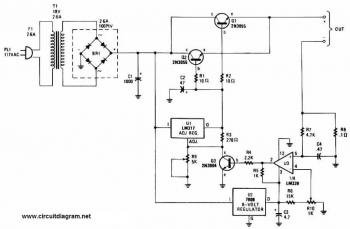
This battery charger circuit is regulated and adjustable, enabling it to charge most NiCAD batteries. It can accommodate both single cells and multiple battery cells connected in series or parallel. The maximum voltage of the batteries should not exceed 18V. Power transistors Q1 and Q2 are configured as series regulators to control the output voltage and charge current rate of the battery charger. An LM-317 adjustable voltage regulator provides the drive signal to the bases of transistors Q1 and Q2. A potentiometer, R9, sets the output voltage level. A current sampling resistor, R8 (a 0.1 ohm/5W unit), is connected between the negative output lead and circuit ground. For each amp of charging current flowing through R8, a 100mV output is developed across it. This voltage is fed to one input of comparator U3, while the other input connects to variable resistor R10. As the charging voltage across the battery begins to drop, the current through R8 decreases, leading to a reduction in the voltage at pin 5 of U3. The output of the comparator follows this change, turning off Q3, which completes the signal's circular path to regulate the battery's charging current.
The described battery charger circuit is designed for versatility in charging NiCAD batteries, accommodating various configurations and ensuring safe operation within the specified voltage limits. The use of power transistors Q1 and Q2 as series regulators allows for efficient control of both the output voltage and the charging current. The LM-317 voltage regulator serves as a crucial component in providing a stable drive signal, ensuring that the transistors operate effectively under varying load conditions.
The potentiometer R9 is integral to setting the desired output voltage level, allowing users to adjust the charging voltage according to the specific requirements of the battery being charged. The current sampling resistor R8 plays a vital role in monitoring the charging current; its low resistance value ensures minimal power loss while providing an accurate voltage drop that corresponds to the charging current. This voltage drop is vital for the feedback mechanism that regulates the charging process.
Comparator U3 is essential for maintaining the desired charging current. It compares the voltage across R8 with the reference voltage set by variable resistor R10. As the battery charges and its voltage increases, the charging current decreases, which is reflected in the voltage across R8. This feedback mechanism allows for precise control over the charging process, preventing overcharging and extending the life of the battery.
The circuit's design emphasizes safety and efficiency, making it suitable for various applications where NiCAD batteries are used. By ensuring that the maximum voltage is capped at 18V, the circuit protects the batteries from damage due to overvoltage conditions. Overall, this battery charger circuit represents a practical solution for charging NiCAD batteries with adjustable parameters and reliable regulation.This battery chargercircuitis regulated and adjustable to make this circuit able to charge the mosto NiCAD battery. This circuit will work for single cell or multi battery cell which connected with series/parallel connection.
The maximum voltage of the batteries should be 18V maximum. Power transistors Q1 and Q2 are connected as series regulators to control the battery charger s output voltage and charge-current rate. An LM-317 adjustable voltage regulator supplies the drive signal to the bases of power transistor Q1 and Q2. Potensiometer R9 sets the output-voltage level. A current sampling resistor, R8 (a 0. 1 ohm/5W unit), is connected between the negative output lead and circuit ground. For each amp of charging current that flows through R8, a 100mV output is developed across it. The voltage developed across R8 is fed to one input of comparator U3. The other input of the comparator is connected to variable resistor R10. As the charging voltage across the battery begins to drop, the current through R8 decrease. Then the voltage feeding pin 5 of U3 decreases, and the comparator output follows, turning Q3 back off, which completes the signal`s circular path to regulate the battery`s charging current.
We aim to transmit more information by carrying articles. Please send us an E-mail to wanghuali@hqew. net within 15 days if we are involved in the problems of article content, copyright or other problems. We will delete it soon. 🔗 External reference
The described battery charger circuit is designed for versatility in charging NiCAD batteries, accommodating various configurations and ensuring safe operation within the specified voltage limits. The use of power transistors Q1 and Q2 as series regulators allows for efficient control of both the output voltage and the charging current. The LM-317 voltage regulator serves as a crucial component in providing a stable drive signal, ensuring that the transistors operate effectively under varying load conditions.
The potentiometer R9 is integral to setting the desired output voltage level, allowing users to adjust the charging voltage according to the specific requirements of the battery being charged. The current sampling resistor R8 plays a vital role in monitoring the charging current; its low resistance value ensures minimal power loss while providing an accurate voltage drop that corresponds to the charging current. This voltage drop is vital for the feedback mechanism that regulates the charging process.
Comparator U3 is essential for maintaining the desired charging current. It compares the voltage across R8 with the reference voltage set by variable resistor R10. As the battery charges and its voltage increases, the charging current decreases, which is reflected in the voltage across R8. This feedback mechanism allows for precise control over the charging process, preventing overcharging and extending the life of the battery.
The circuit's design emphasizes safety and efficiency, making it suitable for various applications where NiCAD batteries are used. By ensuring that the maximum voltage is capped at 18V, the circuit protects the batteries from damage due to overvoltage conditions. Overall, this battery charger circuit represents a practical solution for charging NiCAD batteries with adjustable parameters and reliable regulation.This battery chargercircuitis regulated and adjustable to make this circuit able to charge the mosto NiCAD battery. This circuit will work for single cell or multi battery cell which connected with series/parallel connection.
The maximum voltage of the batteries should be 18V maximum. Power transistors Q1 and Q2 are connected as series regulators to control the battery charger s output voltage and charge-current rate. An LM-317 adjustable voltage regulator supplies the drive signal to the bases of power transistor Q1 and Q2. Potensiometer R9 sets the output-voltage level. A current sampling resistor, R8 (a 0. 1 ohm/5W unit), is connected between the negative output lead and circuit ground. For each amp of charging current that flows through R8, a 100mV output is developed across it. The voltage developed across R8 is fed to one input of comparator U3. The other input of the comparator is connected to variable resistor R10. As the charging voltage across the battery begins to drop, the current through R8 decrease. Then the voltage feeding pin 5 of U3 decreases, and the comparator output follows, turning Q3 back off, which completes the signal`s circular path to regulate the battery`s charging current.
We aim to transmit more information by carrying articles. Please send us an E-mail to wanghuali@hqew. net within 15 days if we are involved in the problems of article content, copyright or other problems. We will delete it soon. 🔗 External reference
